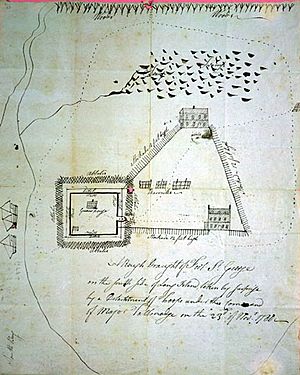Manor St. George facts for kids
Manor St. George was a very large piece of land bought by William "Tangier" Smith way back in the 1600s. It was located on Long Island, in the middle of Suffolk County, New York. This huge area was about 64,000 acres (259 square kilometers)!
Today, parts of this original land are still preserved. The main house and 127 acres (0.51 square kilometers) are called the Manor of St. George and are in Shirley. Another part, 35 acres (0.14 square kilometers) with a house, is known as the Longwood Estate in Ridge. And 35 acres (0.14 square kilometers) became part of the William Floyd Estate.
The Museum Manor of St. George is managed by a special trust. This trust helps share the history of the Smith family, going all the way back to 1683. The Longwood Estate is looked after by the Town of Brookhaven. The Floyd Estate is cared for by the National Park Service. Even the town of Manorville got its name from Manor St. George!
Originally, Manor St. George stretched from the Carmans River in the west to the edge of Southampton Town in the east. It went from the Atlantic Ocean in the south up to where New York State Route 25 is today.
Contents
History of Manor St. George
How the Manor Began
The official document, called a patent, for Manor St. George was given to Col. William "Tangier" Smith in 1693. This was to honor Col. Smith for being the mayor of Tangier in Africa. More land was added to the manor in 1697. Col. Smith already had a home in Setauket, New York. He managed his new large land from there at first.
When Col. William "Tangier" Smith passed away in 1705, his son Major William Henry Smith inherited Manor St. George. Major Smith then built the main manor house on Mastic Neck. Around 1718, about 4,000 acres (16 square kilometers) of the estate were bought by Richard Floyd. He gave this land to his son Nicoll. Later, in 1755, this Floyd Estate was given to William Floyd, who famously signed the Declaration of Independence.
After Major William Henry Smith died in 1743, his son Judge William Smith became the owner of Manor St. George.
The Manor During the American Revolution
During the American Revolution, British soldiers who were loyal to the King took over the manor house on Mastic Neck. They even built a fort there. In 1780, a brave American officer named Major Benjamin Tallmadge led his soldiers, called dragoons, from Cedar Beach. They marched about 20 miles (32 kilometers) to the manor.
The American raid started early in the morning, around 4 a.m. Tallmadge's soldiers quickly captured the fort. Seven British soldiers were killed, but only one American was hurt. This march by Major Tallmadge is still remembered as the Tallmadge Trail. During this raid, Sgt. Elijah Churchill earned the first "Medal of Merit," which is now known as the Purple Heart.
After the War: Changes and Preservation
After the Revolutionary War ended, the Smith family returned to the Manor. Judge Smith had a new house built for his son, Gen. John Smith. However, Gen. Smith chose to stay at Manor St. George. In 1790, a part of the land called Longswamp was given to Judge Smith's seventh son, William. In 1817, William Smith's son, William Sydney Smith, inherited Longswamp and changed its name to Longwood.
Over the years, Manor St. George and Longwood were divided many times. Parts were sold, and other parts were given to the children of the Smith family.
In 1955, Eugenie Annie Tangier Smith set up a special trust to protect Manor St. George. In the same year, the Longwood Estate was given to Elbert "Burt" Clayton Smith. Burt Smith was very generous. He donated 51 acres (0.21 square kilometers) of the estate for Longwood High School. He also gave land to churches and to Suffolk County for a greenbelt area.
When Burt Smith passed away in 1967, real estate developers bought Longwood. It looked like the estate might be destroyed to build new homes and businesses. But people in the community spoke up! Because of this public support, the house and 35 acres (0.14 square kilometers) were given to Brookhaven Town in 1974 to be preserved.
What the Manor Is Used For Today
The Museum Manor of St. George is open to the public for free. You can visit it from May 1 to October 30 each year. The Longwood Estate is now a public park. It also has a museum that visitors can explore.


